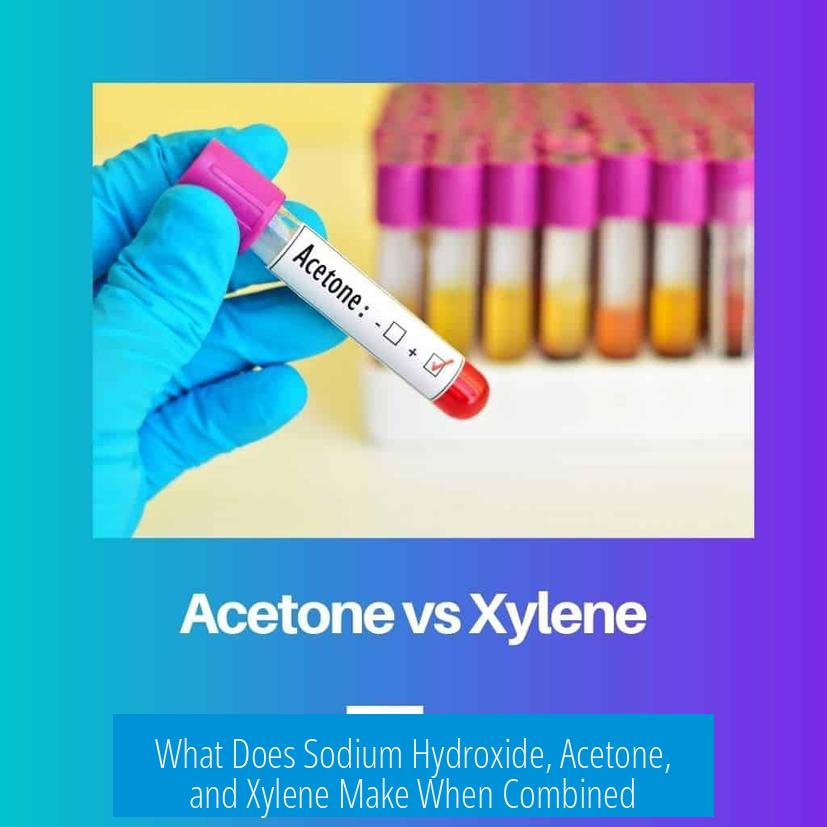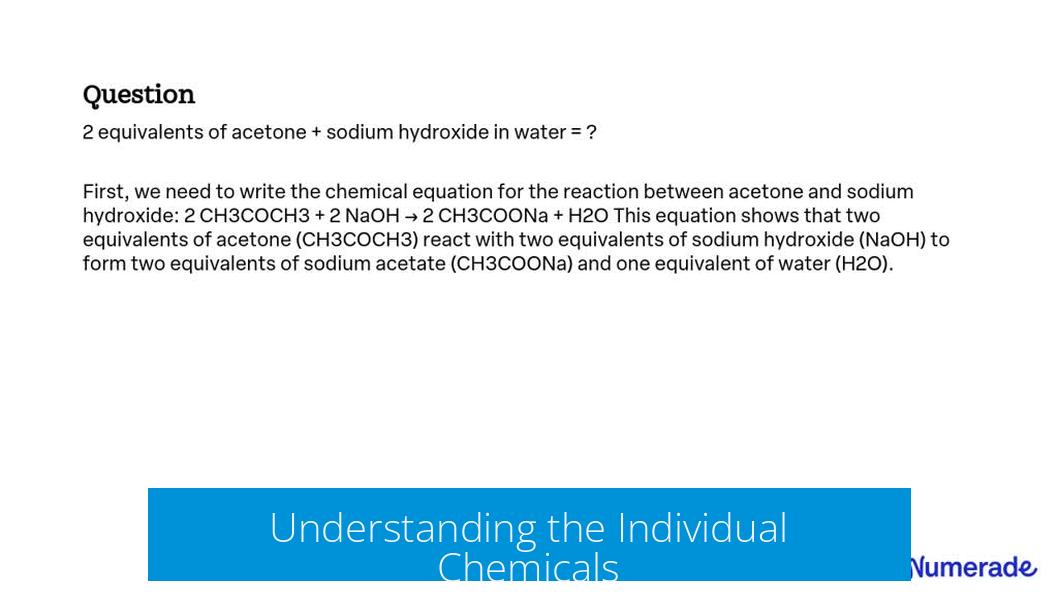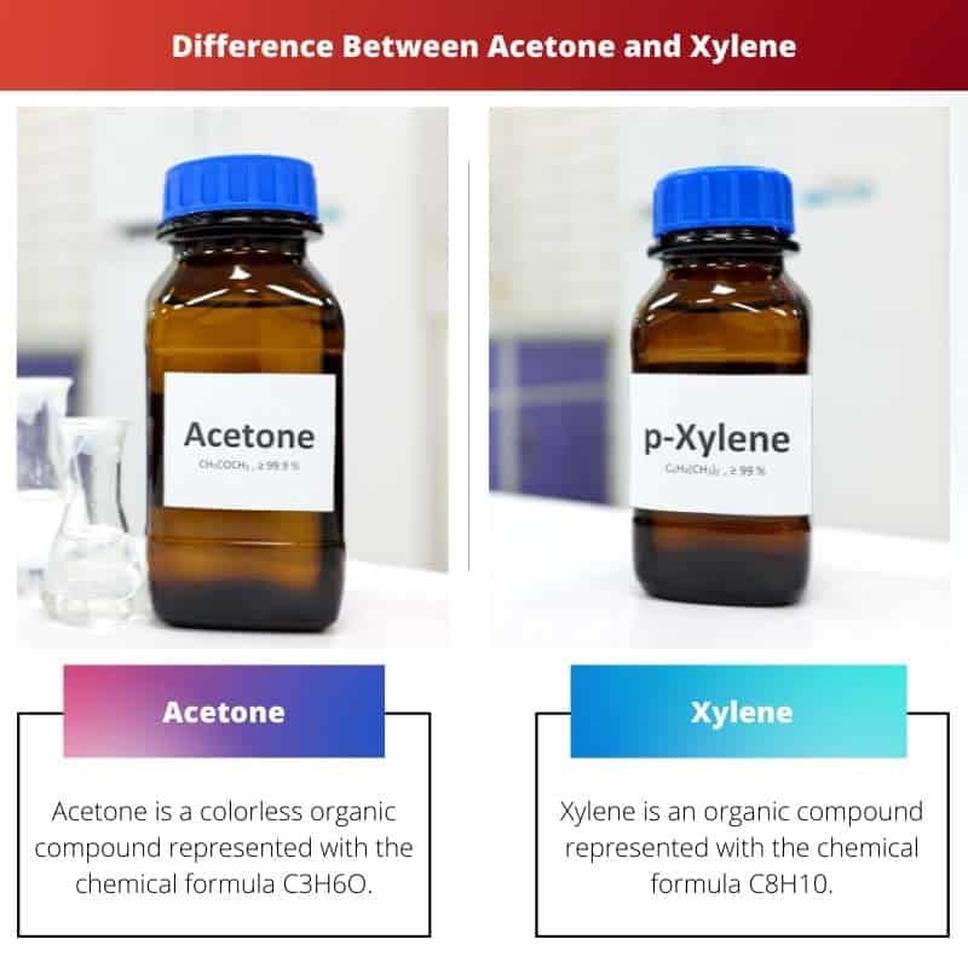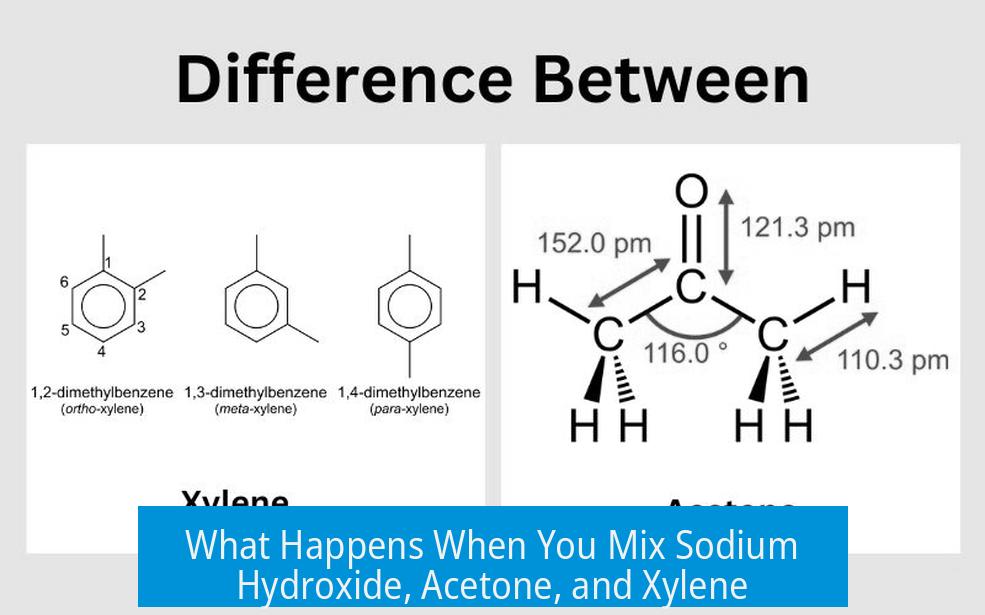What Does Sodium Hydroxide, Acetone, and Xylene Make When Combined?

Sodium hydroxide, acetone, and xylene do not produce any useful or significant chemical product when mixed together. Each compound has distinct chemical properties, but their direct combination fails to yield a new compound or reaction of practical value.
Understanding the Individual Chemicals

Sodium Hydroxide (NaOH)
Sodium hydroxide, also known as caustic soda, is a strong base widely used in chemical processes. It is highly corrosive and reacts violently with water and metals like aluminum. NaOH acts to neutralize acids and catalyze some organic reactions, but it does not react with all substances indiscriminately.

Acetone
Acetone is a common solvent with significant volatility and moderate flammability. It is often used to clean surfaces, dissolve resins or plastics, and as a solvent in various chemical syntheses. Acetone can react with strong bases under controlled conditions, undergoing aldol condensation reactions.
Xylene
Xylene is a mixture of aromatic hydrocarbons commonly employed as a solvent. It is more toxic than acetone, highly flammable, and primarily used in industrial or laboratory extractions. Chemically, xylene is relatively inert to bases such as sodium hydroxide under normal conditions.
Exploring Chemical Interactions Among the Three
Direct Mixing of Sodium Hydroxide, Acetone, and Xylene
- No useful chemical compound forms from mixing all three substances directly.
- They tend to create a heterogeneous mixture, possibly a messy combination, but no significant reaction occurs.
- Xylene remains chemically unchanged when mixed with sodium hydroxide.
Specific Reaction Between Sodium Hydroxide and Acetone
Acetone reacts with sodium hydroxide under basic conditions through an aldol condensation to yield mesityl oxide, a compound with industrial relevance. This reaction involves the formation of carbon-carbon bonds between acetone molecules in the presence of the base.
| Reaction | Reactants | Product | Conditions |
|---|---|---|---|
| Aldol Condensation | Acetone + Sodium Hydroxide | Mesityl oxide | Base-catalyzed, controlled temperature |
| Mixing with Xylene | Xylene + NaOH or Acetone | No chemical reaction | Ambient conditions |
Roles and Uses of Sodium Hydroxide, Acetone, and Xylene
Sodium Hydroxide as a Strong Base
In chemistry, sodium hydroxide is essential as a base for neutralizing acids, hydrolyzing esters or fats, and catalyzing organic transformations. It’s also used in soap making through saponification, where it breaks down fats into soap and glycerol.
Acetone and Xylene as Solvents
Both acetone and xylene serve primarily as solvents in industrial and laboratory settings. Acetone is valued for its rapid evaporation and ability to dissolve polar and nonpolar substances moderately. Xylene is handy in extracting or isolating freebase compounds from solutions due to its non-polarity.
- Acetone cleans precipitates and residue residues.
- Xylene is effective at separating freebase compounds.
- Neither participates actively as reactants in most chemical syntheses but support the reaction environment.
Safety and Handling Concerns
Hazards of Sodium Hydroxide
- Highly corrosive, dissolves proteins and fats on contact.
- Generates intense heat when dissolved in water.
- Reacts violently with moisture-sensitive metals like aluminum.
- Neutralization with mild acids (vinegar or fruit juices) is recommended if skin contact occurs.
- Immediate washing and use of eye protection required during handling.
Hazards of Acetone and Xylene
- Both volatile with flammable vapors; xylene vapors especially flammable and toxic.
- Proper ventilation and storage reduce risk of fire or explosion.
- Neither explodes spontaneously when mixed but ignition sources should be controlled.
Environmental and Waste Considerations
Waste containing sodium hydroxide, acetone, or xylene must be managed as hazardous waste under regulatory frameworks such as the Resource Conservation and Recovery Act (RCRA). Improper disposal can lead to environmental contamination and regulatory penalties.
Summary of Chemical Compatibility and Uses
While sodium hydroxide and acetone can undergo base-catalyzed reactions yielding useful products like mesityl oxide, the addition of xylene does not facilitate or induce any reaction. Xylene remains inert in the presence of sodium hydroxide and functions solely as a solvent. Mixing all three chemicals does not produce any practical chemical compound and is generally discouraged except for intended solvent or washing applications.
Key Takeaways
- No useful product forms by mixing sodium hydroxide, acetone, and xylene directly.
- Acetone reacts with sodium hydroxide via aldol condensation to produce mesityl oxide.
- Xylene remains inert to sodium hydroxide and does not react with acetone in these conditions.
- Each chemical serves a different role: NaOH as a strong base, acetone and xylene as solvents.
- All three chemicals require careful handling due to corrosivity, flammability, and toxicity risks.
- Proper waste management is necessary to avoid environmental contamination and comply with regulations.
What Does Sodium Hydroxide, Acetone, and Xylene Make?
Short answer: If you’re hoping these three chemicals mixed together will produce some magical new compound, brace yourself—they don’t. At least, not anything useful. Mixing sodium hydroxide, acetone, and xylene directly does not yield any notable product. Instead, you just get a messy mix of chemicals that largely keep to themselves. It’s chemistry’s version of an awkward dinner party where no one really hits it off.
Before you get too disappointed, let’s unpack what happens—and more importantly, what could happen when only some of these players interact.
Why Mixing Them All Together Doesn’t Spark Magic
Imagine sodium hydroxide (NaOH) as a powerful bouncer at the chemical club. It’s a strong base, ready to grab and hold any acidic guests. Acetone and xylene, meanwhile, are the solvent socialites, floating around and dissolving other substances without much fuss.
When all three enter the scene, NaOH and acetone might glance at each other cautiously, but xylene largely ignores the party. No bond forms. The mixture remains a logistical headache at best, producing no new molecule worth noting. It’s like trying to mix oil, water, and vinegar; unless you shake them vigorously, they refuse to mingle.
The Specific Interaction: Acetone Meets Sodium Hydroxide
Now, here’s the exciting part! Sodium hydroxide and acetone can collaborate under the right conditions. When acetone meets NaOH, it can undergo a reaction called aldol condensation. This fancy term boils down to acetone molecules linking up to form mesityl oxide.
Mesityl oxide is an important intermediate in organic chemistry, useful in making fragrances, solvents, and other chemicals. Think of this reaction as a neat handshake between acetone and sodium hydroxide—one that invites acetone molecules to combine and form something more complex.
But remember, this reaction requires specific conditions: controlled temperature, concentration, and timing. Throwing xylene into the mix won’t help or hinder since xylene remains chemically indifferent.
Xylene’s Curiously Detached Role
Xylene is the wallflower here. Despite being a solvent like acetone, it doesn’t react with sodium hydroxide. It hangs out quietly, perhaps helping dissolve substances or extracting freebase compounds in industry, but chemically, it won’t combine or transform alongside NaOH or acetone in any meaningful way.
Fun fact: Among the three, xylene is the most toxic and also highly flammable. It’s a party guest you want to keep comfortable but under careful watch.
What Are These Chemicals Normally Used For?
Individually, these three have well-established careers:
- Sodium Hydroxide: The heavyweight champion of bases. NaOH is essential in soap-making, where it saponifies fats and oils. It’s reactive and powerful, capable of dissolving proteins and fats, so you need to handle it with care.
- Acetone: The go-to solvent queen. Acetone cleans finished products and precipitates. It’s less volatile to ignite than you might think—you actually need an open flame, not just sparks, to get it going.
- Xylene: The extraction specialist. Xylene helps separate or ‘pull out’ freebase substances from solutions. Beware of its toxicity and flammability; it demands respect in handling.
Think of them as support crew members rather than star performers. They facilitate chemical reactions or processes but usually aren’t raw materials themselves.
Safety Drama and Real-World Handling
Mixing chemicals always sounds like a science experiment waiting to explode in movies, right? Reality throws a wet blanket on that scene here with a less exciting but crucial message: these chemicals can be dangerous but won’t spontaneously combust if mixed.
Sodium hydroxide is highly corrosive. It generates heat when dissolved in water and reacts violently with metals like aluminum. It’s a moisture magnet, pulling water from the air—or your skin—which turns it increasingly nasty. If you get this on you, wash immediately, preferably with vinegar or acidic drinks like cola. Nope, that’s not an old wives’ tale but good emergency advice.
Acetone and xylene vapors are flammable. Storing large quantities without proper ventilation and sealing is asking for trouble. Think fire hazard, not explosion—but still, caution is the name of the game.
Environmentally, improper disposal of these chemicals can trigger enforcement from agencies like the EPA. They’re hazardous waste, so respect the proper protocols.
What’s the Takeaway?
So what do sodium hydroxide, acetone, and xylene make when thrown together? Not much besides a chemical cocktail that stays stubbornly mixed but unreactive. However, sodium hydroxide and acetone alone can dance a chemical dance to form mesityl oxide, a useful organic compound.
If you handle these chemicals, do so with awareness and respect for their nature. Use sodium hydroxide for its base strength, acetone and xylene for solvent purposes—but don’t expect combining all three to change the world.
Next time you hear someone casually asking, “What does sodium hydroxide, acetone, and xylene make?”—you’ll have the answer ready, wrapped in science, safety, and a bit of chemical reality.
What do sodium hydroxide, acetone, and xylene produce when mixed together?
Mixing these three chemicals directly does not create any useful product. They mainly form a messy mixture without a significant reaction.
Can sodium hydroxide react with acetone to form a compound?
Yes. Sodium hydroxide can catalyze aldol condensation of acetone, producing mesityl oxide under proper conditions.
Does xylene react with sodium hydroxide?
No. Xylene does not react with sodium hydroxide and remains unchanged when combined.
What roles do sodium hydroxide, acetone, and xylene play chemically?
Sodium hydroxide acts as a strong base. Acetone and xylene serve mainly as solvents in various lab and industrial processes.
Are there any safety concerns when handling these chemicals together?
Yes. Sodium hydroxide is corrosive. Acetone and xylene vapors are flammable, and xylene is the most toxic among them, requiring careful handling.





Leave a Comment